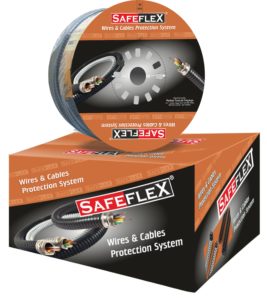For wire and cable applications where high temperature service rating and superior electrical properties are critical for protection, We offers a wide variety of insulating and protection options. Applications include harnesses for electrical wiring in automotive and cord covers, wire protectors, cable protectors, spacers for transformers and other electrical insulation applications where reliability is critical.
APPLICATION:
- Industrial Facilities: Safeguarding wiring and cables in industrial environments where machinery, equipment, and heavy traffic may pose risks of damage or wear.
- Outdoor Installations: Protecting electrical wiring and cables in outdoor settings against exposure to weather elements such as rain, snow, and UV radiation.
- Underground Wiring: Shielding underground electrical cables from moisture, soil erosion, and physical damage caused by digging or construction activities.
- Hazardous Areas: Providing insulation and protection for wiring and cables in hazardous locations such as chemical plants, oil refineries, and explosive atmospheres.
- Automotive and Marine Applications: Ensuring the safety and reliability of wiring systems in vehicles, boats, and marine vessels by guarding against abrasion, vibration, and moisture ingress.
CONSTRUCTION :
Building wire and cable protection systems involves careful planning and setting up to keep electrical setups safe. This includes choosing the right materials like PVC or metal conduits and arranging them in a way that avoids potential dangers. It’s important to install them properly, considering factors like temperature and moisture, to make sure wiring and cables are shielded from harm.
SPECIFICATION:
- Material: Selecting suitable materials such as PVC, metal, or fiberglass for conduits based on environmental factors and application requirements.
- Size: Choosing the appropriate diameter and length of conduits to accommodate the wiring and cables being protected.
- Installation Method: Determining the best method for installing conduits, including surface mounting, burying underground, or running through walls or ceilings.
- Compatibility: Ensuring compatibility with other electrical components and systems to facilitate seamless integration and functionality.

